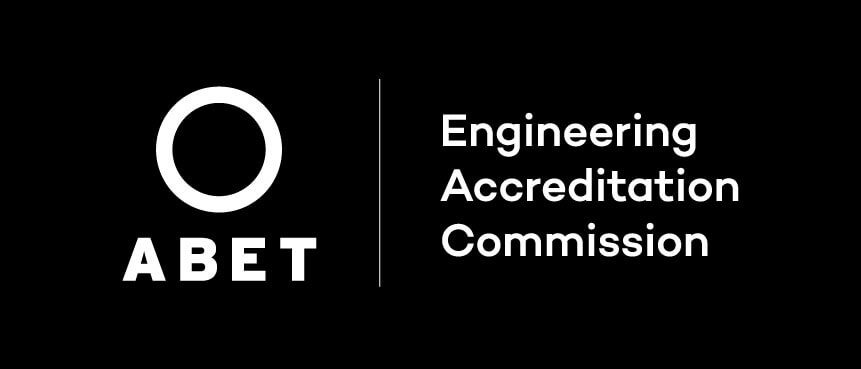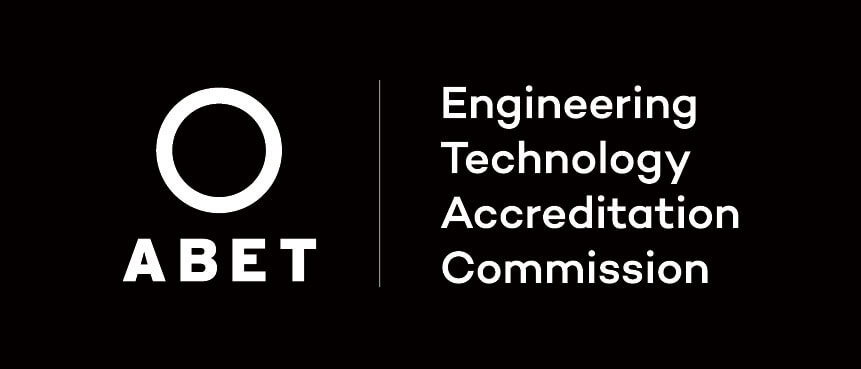Our programs are all accredited, meaning you can trust the quality of the education you receive. This distinction also leads to more career opportunities. For example, you must graduate from an accredited school to be licensed or certified in technical professions or to work for multinational corporations.
ABET
 Programs accredited by the Engineering Accreditation Commission of ABET, https://www.abet.org.
Programs accredited by the Engineering Accreditation Commission of ABET, https://www.abet.org.
- Acoustical Engineering and Music
- Aerospace Engineering
- Biomedical Engineering
- Civil Engineering
- Computer Engineering
- Electrical Engineering
- Mechanical Engineering
 Programs accredited by the Engineering Technology Accreditation Commission of ABET, https://www.abet.org.
Programs accredited by the Engineering Technology Accreditation Commission of ABET, https://www.abet.org.
NASM
 Program accredited by the National Association of Schools of Music (NASM).
Program accredited by the National Association of Schools of Music (NASM).
State of Connecticut Office of Higher Education

All CETA programs are licensed and accredited by the State of Connecticut Office of Higher Education. The Board of Higher Education of the State of Connecticut recognizes the following undergraduate programs:
- Acoustical Engineering & Music
- Aerospace Engineering
- Architectural Design + Technology
- Audio Engineering Technology
- Biomedical Engineering
- Civil Engineering
- Computer Engineering
- Computer & Electronic Engineering Technology
- Electrical Engineering
- Electromechanical Engineering Technology
- Electronic Engineering Technology
- Interdisciplinary Engineering Studies
- Mechanical Engineering
- Robotics Engineering
The Board of Higher Education of the State of Connecticut also recognizes the following graduate programs:
- Master of Architecture
- Master of Engineering
- Master of Science in Engineering
NAAB
Accreditation for Master of Architecture
 The Master of Architecture program is accredited by the National Architectural Accrediting Board (NAAB). The University of Hartford's Department of Architecture offers the following NAAB-accredited degree program(s):
The Master of Architecture program is accredited by the National Architectural Accrediting Board (NAAB). The University of Hartford's Department of Architecture offers the following NAAB-accredited degree program(s):
- M.Arch Track 1 – 48 graduate credits (3 semesters) with a preprofessional architecture degree from the University of Hartford.
- M.Arch Track 2 - 64 graduate credits (4 semesters) with a preprofessional architecture degree.
- M.Arch Track 3 - 113 graduate credits (7 semesters) with any 4-year bachelor’s degree.
In the United States, most registration boards require a degree from an accredited professional degree program as a prerequisite for licensure. The National Architectural Accrediting Board (NAAB), which is the sole agency authorized to accredit professional degree programs in architecture offered by institutions with U.S. regional accreditation, recognizes three types of degrees: the Bachelor of Architecture, the Master of Architecture, and the Doctor of Architecture. A program may be granted an eight-year term, an eight-year term with conditions, or a two-year term of continuing accreditation, or a three-year term of initial accreditation, depending on the extent of its conformance with established education standards.
Doctor of Architecture and Master of Architecture degree programs may require a non-accredited undergraduate degree in architecture for admission. However, the non-accredited degree is not, by itself, recognized as an accredited degree.
Process of Evaluating the Content of a Non-accredited Degree
The Department of Architecture welcomes students who have earned a pre-professional architecture degree (not accredited by NAAB) or an undergraduate degree in a discipline other than architecture.
Students applying who have completed or will complete a pre-professional architecture degree prior to the start of the next academic year will be admitted into our Track 2 Master of Architecture program following a review of their transcript to confirm that the courses completed under the pre-professional degree align with the expectations and requirements to enter the 2-year Master of Architecture. If the pre-professional curriculum was lacking in specific areas the student would be expected to complete the relevant courses to satisfy the missing content prior to matriculating in the 2-year Master of Architecture curriculum.
Students applying who have completed or will complete an undergraduate BS or BA degree in a discipline other than architecture prior to the start of the next academic year will be admitted into our Track 3 Master of Architecture program following a review of their transcript. The review determines any advanced standing based on completed relevant courses. Students in Track 3 must complete Physics I and Calculus I, and Calculus II prior to the start of their first semester in the Track 3 Master of Architecture program.
Student’s transcripts are evaluated and compared to required courses for admission directly into the Master of Architecture Track 2 or Track 3 program. The Department Chair and the Graduate Program Director review transcripts and, when necessary due to lacking one or more prerequisite courses, complete the Prerequisite Evaluation for Graduate Admission form. This form is then used to assure students complete the required courses lacking in the pre-professional or other discipline curriculum, respectively.
Statements/Policies on DEIJB
The Mission of the Department of Architecture provides a foundational setting regarding learning and teaching culture. The Mission of the Department of Architecture is:
The Department of Architecture is a diverse community of practitioners, teachers, and students dedicated to educating future architectural professionals and growing the knowledge base of the profession. Our commitment is to engage architecture in its civic, social, and professional realms for the ultimate benefit of the built environment and those who use it.
In addition, our Studio Culture Statement expands on the expectations of students, faculty, and staff in the Department regarding the learning environment. See our Studio Culture Statement here.
Documents Relative to NAAB Accreditation:
- NAAB Special Report Decision Letter
- NAAB Special Report Response
- NAAB Annual Report Decision Letter 2023
- 2020 NAAB Conditions for Accreditation (PDF)
- 2020 NAAB Procedures for Accreditation (PDF)
- NCARB Pass Rates
- Non-Pre-Professional Pre-Requisite Evaluation Form (PDF)
- Admission & Financial Aid Information
- 2020 NAAB IPR Letter response (PDF)
- 2019 NAAB Interim Progress Report (IPR) (PDF)
- 2019 NAAB Decision Letter (Track 3) (PDF)
- 2019 NAAB Track 3 Substantial Change Application (PDF)
- 2018 NAAB Decision Letter (Track 1) (PDF)
- 2018 NAAB Track 1 Substantial Change Application (PDF)
- 2017 NAAB Decision Letter (Track 2) (PDF)
- 2017 NAAB Visiting Team Report (VTR) (PDF)
- 2016 NAAB Accreditation Program Report (APR) (PDF)
- 2015 NAAB Procedures for Accreditation (PDF)
- 2014 NAAB Conditions for Accreditation (PDF)
Student Enrollment and Graduation Statistics
2020-21 Academic Year
| Program | Enrolled | Graduates |
|---|---|---|
| Acoustical Engineering and Music, BSE | 35 | 7 |
| Biomedical Engineering, BSBE | 54 | 12 |
| Civil Engineering, BSCE | 88 | 21 |
| Computer Engineering, BSCompE | 62 | 15 |
| Electrical Engineering, BSEE | 94 | 20 |
| Mechanical Engineering, BSME | 155 | 42 |
2018-19 Academic Year
| Program | Enrolled | Graduates |
|---|---|---|
| Architectural Engineering Technology, BS | 169 | 31 |
| Electronic Engineering Technology, BS | 12 | 2 |
| Computer and Electronic Engineering Technology, BS | 20 | 2 |
| Electromechanical Engineering Technology, BS | 67 | 15 |
2018-19 Academic Year
| Program | Enrolled | Graduates |
|---|---|---|
| Audio Engineering Technology, BS | 83 | 18 |
| Interdisciplinary Engineering Studies, BS | 1 | 1 |
Robotics Engineering Student Enrollment and Graduation Statistics
| Academic Year | First-Year | Sophomore | Junior | Senior | Total Graduates |
|---|---|---|---|---|---|
| 20-21 | 3 | 3 | 1 | 0 | 0 |
| 21-22 | 5 | 4 | 2 | 1 | 0 |
| 22-23 | 4 | 5 | 7 | 2 | 2 |
| 23-24 | 8 | 5 | 4 | 5 | 3 |
Aerospace Engineering Student Enrollment and Graduation Statistics
| Academic Year | First-Year | Sophomore | Junior | Senior | Total Graduates |
|---|---|---|---|---|---|
| 22-23 Full Time | 14 | 6 | 4 | 4 | 28 |
| 22-23 Part Time | 1 | 0 | 0 | 1 | 2 |
| 21-22 Full Time | 6 | 2 | 0 | 1 | 9 |
| 21-22 Part Time | 0 | 0 | 0 | 0 | 0 |
Electromechanical Engineering Technology Student Enrollment and Graduation Statistics
| Academic Year | First-Year | Sophomore | Junior | Senior | Total Graduates |
|---|---|---|---|---|---|
| 24-25 | 12 | 8 | 9 | 9 | 7 |
| 23-24 | 6 | 9 | 11 | 4 | 2 |
| 22-23 | 14 | 6 | 4 | 7 | 7 |
| 21-22 | 3 | 8 | 6 | 12 | 11 |
| 20-21 | 10 | 9 | 13 | 11 | 9 |
| 19-20 | 12 | 12 | 12 | 17 | 13 |
Computer and Electronic Engineering Technology Student Enrollment and Graduation Statistics
| Academic Year | First-Year | Sophomore | Junior | Senior | Total Graduates |
|---|---|---|---|---|---|
| 24-25 | 7 | 1 | 6 | 6 | 5 |
| 23-24 | 6 | 5 | 7 | 3 | 4 |
| 22-23 | 10 | 8 | 4 | 1 | 10 |
| 21-22 | 10 | 3 | 3 | 12 | 8 |
| 20-21 | 7 | 2 | 6 | 3 | 3 |
| 19-20 | 2 | 3 | 3 | 3 | 3 |